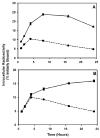Evaluation of an anti-p185(HER2) (scFv-C(H)2-C(H)3)2 fragment following radioiodination using two different residualizing labels: SGMIB and IB-Mal-D-GEEEK
- PMID: 19647173
- PMCID: PMC2720881
- DOI: 10.1016/j.nucmedbio.2009.04.002
Evaluation of an anti-p185(HER2) (scFv-C(H)2-C(H)3)2 fragment following radioiodination using two different residualizing labels: SGMIB and IB-Mal-D-GEEEK
Abstract
Introduction: A 105-kDa double mutant single-chain Fv-Fc fragment (scFv-Fc DM) derived from the anti-p185(HER2) hu4D5v8 antibody (trastuzumab; Herceptin) has been described recently. The goal of this study was to investigate whether improved tumor targeting could be achieved with this fragment through the use of residualizing radioiodination methods.
Methods: The scFv-Fc DM fragment was radioiodinated using N-succinimidyl 4-guanidinomethyl 3-[(131)I]iodobenzoate ([(131)I]SGMIB) and N(epsilon)-(3-[(131)I]iodobenzoyl)-Lys(5)-N(alpha)- maleimido-Gly(1)-GEEEK ([(131)I]IB-Mal-D-GEEEK), two residualizing radioiodination agents that have been used successfully with intact antibodies. Paired-label internalization assays of the labeled fragments were performed in vitro using MCF7 human breast cancer cells transfected to express HER2 (MCF7-HER2); comparisons were made to scFv-Fc DM directly radioiodinated using Iodogen. The tissue distribution of the scFv-Fc DM labeled with [(125)I]IB-Mal-d-GEEEK and [(131)I]SGMIB was compared in athymic mice bearing MCF7-HER2 xenografts.
Results: The scFv-Fc DM fragment was labeled with [(131)I]SGMIB and [(131)I]IB-Mal-d-GEEEK in conjugation yields of 53% and 25%, respectively, with preservation of immunoreactivity for HER2. Internalization assays indicated that labeling via SGMIB resulted in a 1.6- to 3.5-fold higher (P<.05) retention of radioactivity, compared to that from the directly labeled fragment, in HER2-expressing cells during a 24-h observation period. Likewise, the amount of radioactivity retained in cells from the IB-Mal-d-GEEEK-labeled fragment was 1.4- to 3.3-fold higher (P<.05). Tumor uptake of radioiodine activity in athymic mice bearing MCF7-HER2 xenografts in vivo was significantly higher for the [(125)I]IB-Mal-d-GEEEK-labeled scFv-Fc DM fragment compared with that of the [(131)I]SGMIB-labeled fragment, particularly at later time points. The uptake of (125)I was threefold (3.6+/-1.1 %ID/g vs. 1.2+/-0.4 %ID/g) and fourfold (3.1+/-1.7 %ID/g vs. 0.8+/-0.4 %ID/g) higher than that for (131)I at 24 and 48 h, respectively. However, the [(125)I]IB-Mal-d-GEEEK-labeled scFv-Fc DM fragment also exhibited considerably higher levels of radioiodine activity in liver, spleen and kidney.
Conclusions: The overall results further demonstrate the potential utility of these two prosthetic groups for the radiohalogenation of internalizing monoclonal antibodies and their fragments. Specifically, the trastuzumab-derived double mutant fragment in combination with these residualizing agents warrants further evaluation for imaging and possibly treatment of HER2 expressing malignancies.
Figures





References
-
- Akabani G, Carlin S, Welsh P, Zalutsky MR. In vitro cytotoxicity of 211At-labeled trastuzumab in human breast cancer cell lines: effect of specific activity and HER2 receptor heterogeneity on survival fraction. Nucl Med Biol. 2006;33:333–47. - PubMed
-
- Behe M, Kluge G, Becker W, Gotthardt M, Behr TM. Use of polyglutamic acids to reduce uptake of radiometal-labeled minigastrin in the kidneys. J Nucl Med. 2005;46:1012–5. - PubMed
-
- Benz CC, Scott GK, Sarup JC, Johnson RM, Tripathy D, Coronado E, et al. Estrogen-dependent, tamoxifen-resistant tumorigenic growth of MCF-7 cells transfected with HER2/neu. Breast Cancer Res Treat. 1992;24:85–95. - PubMed
-
- Borchardt PE, Yuan RR, Miederer M, McDevitt MR, Scheinberg DA. Targeted actinium-225 in vivo generators for therapy of ovarian cancer. Cancer Res. 2003;63:5084–90. - PubMed
Publication types
MeSH terms
Substances
Grants and funding
LinkOut - more resources
Full Text Sources
Other Literature Sources
Research Materials
Miscellaneous

